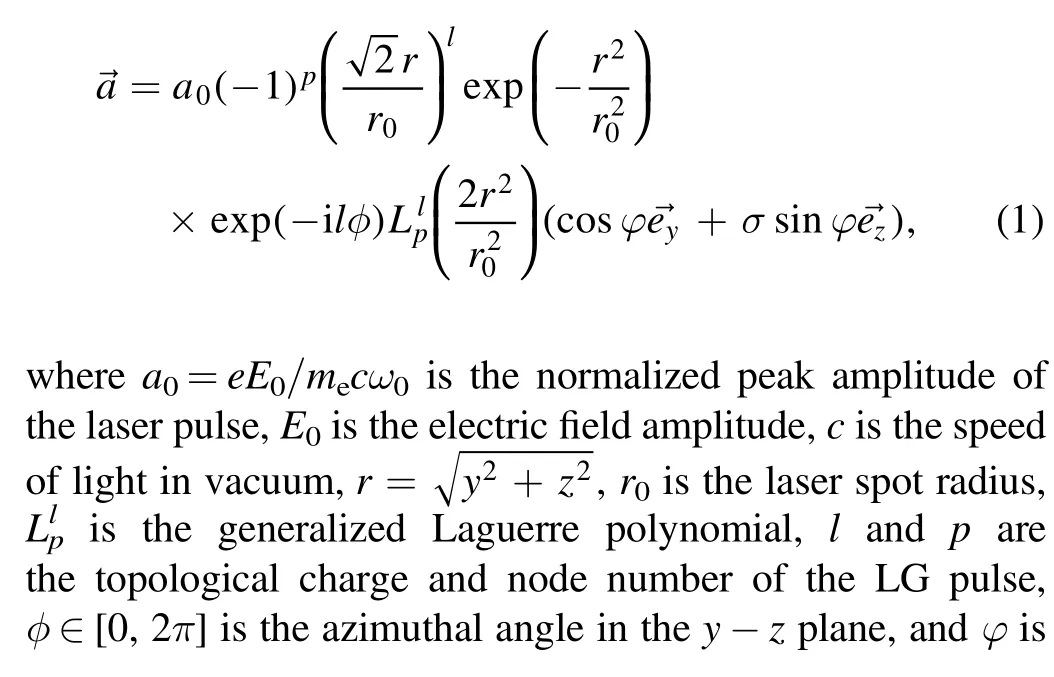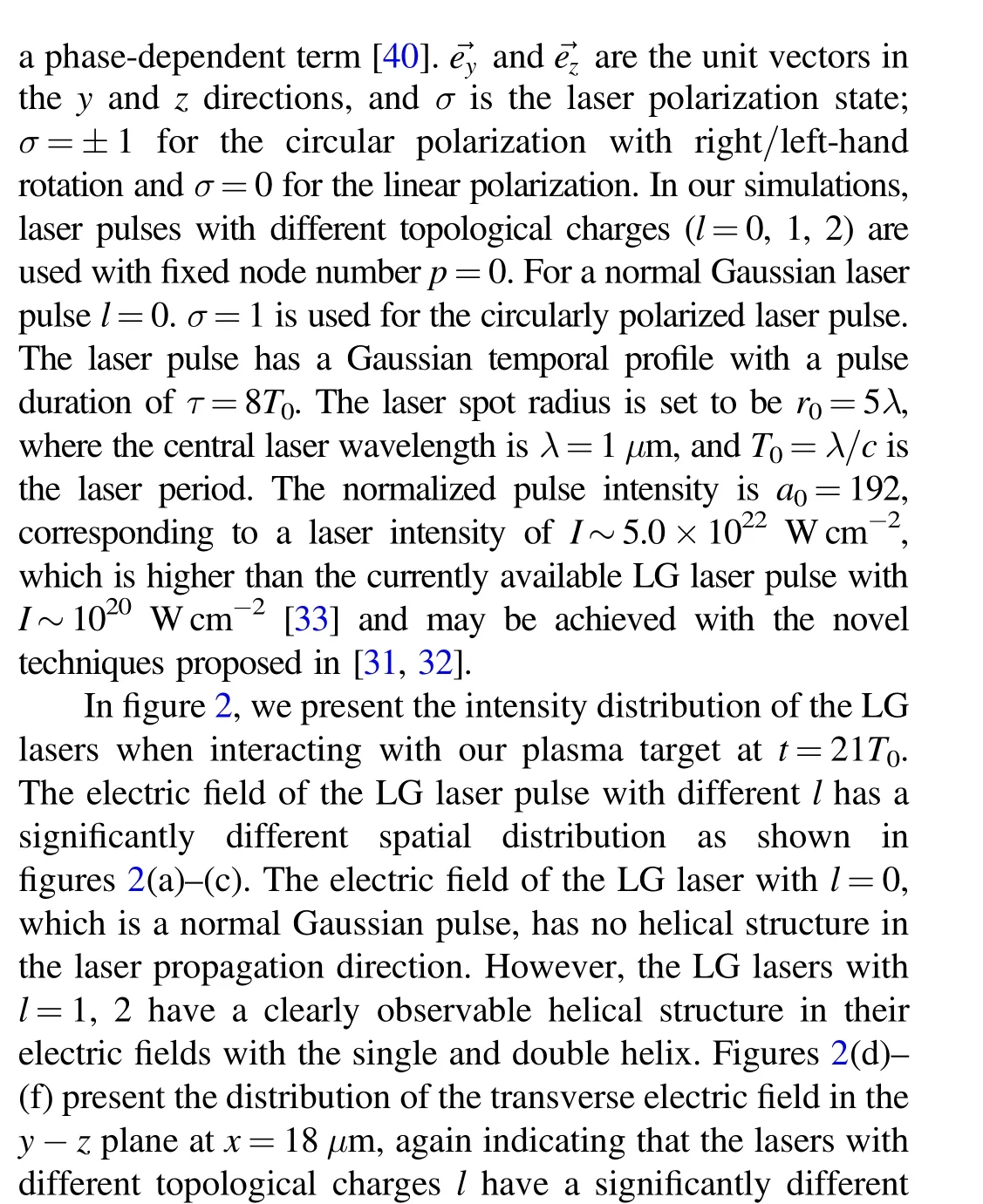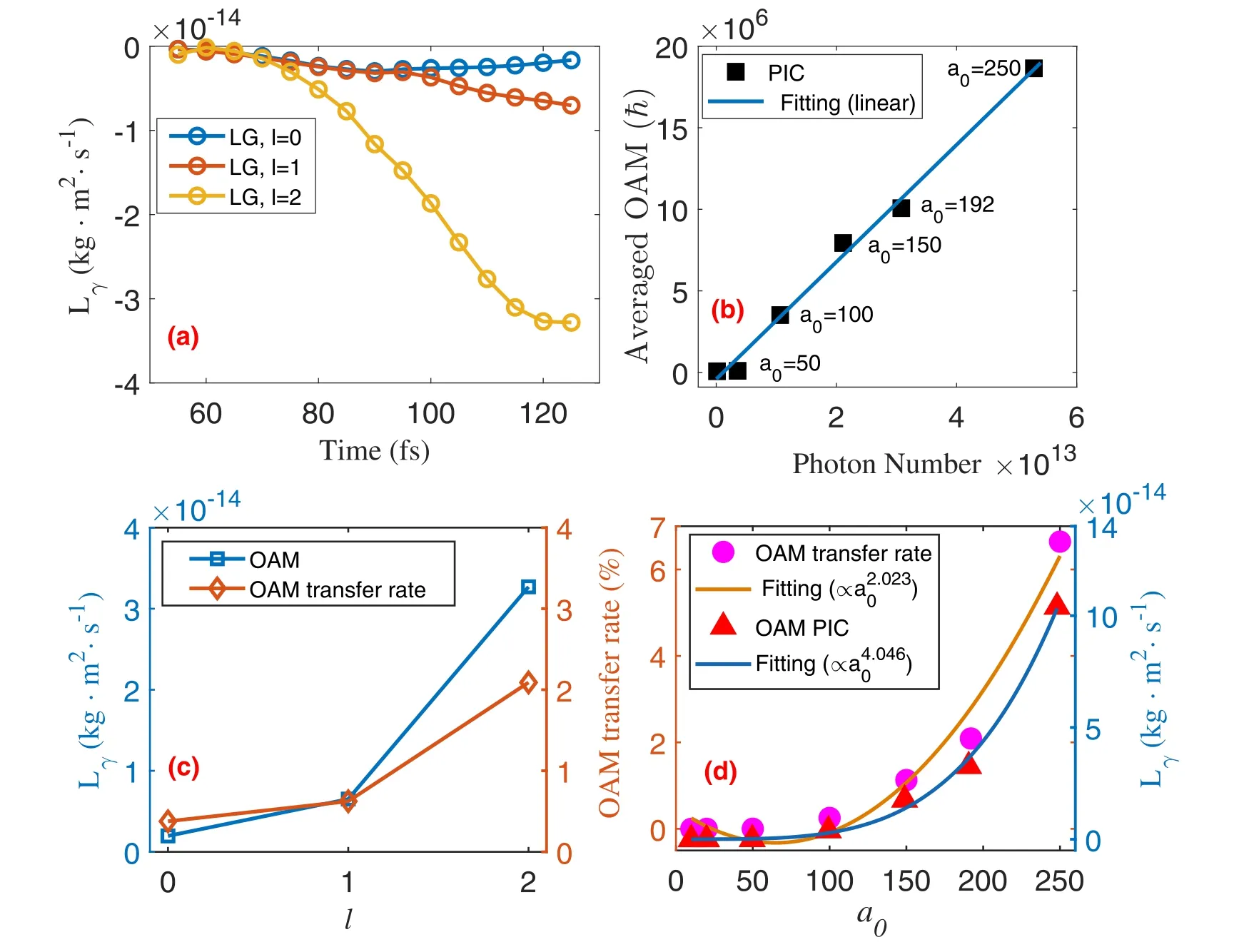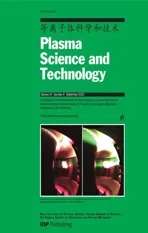Bright γ-ray source with large orbital angular momentum from the laser near-criticalplasma interaction
2022-08-29MamatAliBAKESuoTANG唐琐andBaisongXIE谢柏松
Mamat Ali BAKE, Suo TANG (唐琐) and Baisong XIE (谢柏松)
1 Xinjiang Key Laboratory of Solid State Physics and Devices, Xinjiang University, Urumqi 830046,People's Republic of China
2 School of Physics Science and Technology,Xinjiang University,Urumqi 830046,People's Republic of China
3 Key Laboratory of Beam Technology of the Ministry of Education, and College of Nuclear Science and Technology, Beijing Normal University, Beijing 100875, People's Republic of China
4 College of Physics and Optoelectronic Engineering, Ocean University of China, Qingdao 266100,
People's Republic of China
Abstract We propose a new laser-plasma-based method to generate bright γ-rays carrying large orbital angular momentum by interacting a circularly polarized Laguerre-Gaussian laser pulse with a near-critical hydrogen plasma confined in an over-dense solid tube. In the first stage of the interaction, it is found via fully relativistic three-dimensional particle-in-cell simulations that high-energy helical electron beams with large orbital angular momentum are generated. In the second stage, this electron beam interacts with the laser pulse reflected from the plasma disc behind the solid tube, and helical γ beams are generated with the same topological structure as the electron beams.The results show that the electrons receive angular momentum from the drive laser,which can be further transferred to the γ photons during the interaction.The γ beam orbital angular momentum is strongly dependent on the laser topological charge l and laser intensity a0,which scales as L∝a04 γ. A short (duration of 5 fs) isolated helical γ beam with an angular momentum of -3.3×10-14 kg m2 s-1 is generated using the Laguerre-Gaussian laser pulse with l=2. The peak brightness of the helical γ beam reaches 1.22×1024 photons s-1 mm-2 mrad-2 per 0.1% BW (at 10 MeV), and the laser-to-γ-ray angular momentum conversion rate is approximately 2.1%.
Keywords: laser plasma interaction, Laguerre-Gaussian laser, γ-ray emission, orbital angular momentum, particle-in-cell simulation
1. Introduction
Gamma(γ)rays have broad application in areas of science and technology such as medicine, biology, industry, materials science, and high-energy-density science [1, 2]. High-energy electrons can generate γ-rays from traditional accelerators,which are expensive and bulky [3]. With the rapid development of laser technologies[4,5],recent studies have indicated that laser-plasma-based accelerators are more compact and less expensive than conventional accelerators [6-8]. The laserplasma accelerators are an alternative way to generate highenergy X-and γ-rays[9-12]by synchrotron radiation[13,14],bremsstrahlung [15, 16], and nonlinear Compton scattering[17-22] processes. Accordingly, recent studies involving both theory and experiments have shown that energetic,collimated,and brilliant γ-rays can be obtained by an all-optical method by intense laser interaction with plasmas[23-29].However,most of them do not include the γ beam orbital angular momentum(OAM), which also has potential application in many areas.With an additional degree of freedom, γ beams with OAM carry more information and provide a unique tool to learn more about the dynamics of particles,the nuclear structure,and some critical astrophysical phenomena.One efficient alternative way to generate γ-rays with OAM is the interaction of a vortex light beam with plasma.
The vortex characteristics and OAM of the Laguerre-Gaussian (LG) laser pulse were first demonstrated by Allen et al nearly 30 years ago[30].However,the intensity of the LG laser has been under relativistic intensity. Thus, it strongly restricts the application of the LG lasers for generating vortex γ beams in plasma and other related applications. Recently,approaches for achieving vortex laser pulses with relativistic intensities have been developed, and they are widely used in many applications [31-33]. Vortex LG laser pulses with relativistic intensities have opened new avenues for laser-plasmabased novel particle accelerators and γ-ray sources carrying OAM[34-42].Studies have shown that during the interaction of an intense LG laser with plasma,the angular momentum can be effectively transferred from the laser pulse to the electron beams.Therefore, the electrons have new degrees of freedom,which is essential for controlling the microstructure of the electron beams in the plasma channel[34,35].Meanwhile,the OAM of the electrons can be further transferred to the γ-ray photons. Thus, it can generate energetic, brilliant, helical γ beams with controllable OAM[40-43].In particular,energetic electrons and γ beams carrying OAM have extensive applications in donut Wakefield acceleration and optical control of the topology of laser-plasma accelerators [44, 45], generation of ultrashort electron beams [35], generation of high-order harmonics [46, 47], generation of polarized γ beams and positrons [9], and other areas of science and technology. For example, normal photons are converted into twisted photons with OAM around Kerr black holes,and it should be possible to detect and measure these vortex photons, thus allowing a direct observational demonstration of the existence of Kerr black holes [48]. The γ-ray with OAM is a unique tool in the detection of strong dichroic effects in materials [49] and realization of the spin-Hall effect in a neutral atomic system[50].Nevertheless, the generation of high-energy γ-rays with large OAM and high brightness is very cumbersome.Controlling the topological structure and enhancing the OAM transfer efficiency are also still challenging. Therefore, studies on the generation of γ beams with large OAM in the interaction of relativistic LG lasers and plasma have received significant attention in recent years. There are many open questions that are being investigated.
In this work,we propose a scheme to generate brilliant γrays with controllable OAM using an intense LG laser pulse interacting with a near-critical-density (NCD) plasma, which has been demonstrated via a set of three-dimensional (3D)quantum electrodynamics (QED) particle-in-cell (PIC) simulations.The results indicate that the electrons are first trapped by the combined effects of the special distribution of the vortex laser field and accelerated in the NCD plasma channel,generating helical electron beams with large OAM. Consequently, the relativistic vortical motion of such helically distributed electrons can generate bright vortex γ-rays with large OAM through nonlinear Compton scattering. It was found that by using LG laser pulses, the helical structure and OAM of the beams are strongly related to the LG laser intensity and topological charge. Therefore, in the proposed scheme,the helical structure and the OAM of the γ beams are easily manipulated by controlling the laser parameters, such as laser intensity and topological charge.

Figure 1.Proposed scheme for γ-ray production. An intense circularly polarized (CP) LG laser (green isosurface) interacts with NCD plasma inside a solid aluminum tube. The left side of the tube is open, while the right side is closed. For convenience, only the initial setup of the CP LG01 laser is shown in the figure.
2. Simulation setup and QED emission model
In this section, we first describe the setup of our simulations and the γ-ray generation scheme in our interaction model.The brilliant γ-rays with controllable OAM are generated in the collision between highly intense LG laser pulses and an NCD hydrogen plasma inside a tube of over-dense aluminum plasma as shown in figure 1.
The target is an over-dense aluminum tube(ne=500 nc)filled with NCD hydrogen plasma (ne=nc), wherenc=me4πe2is the critical plasma density corresponding to the initial laser frequency ω0,and meand e are the mass and charge of the electron. Such NCD plasma can be produced by laser beams focusing on gas jets, foam, or cluster jets[51].The aluminum tube serves as an optical waveguide for the laser pulse and helps to generate a quasistatic azimuthal magnetic field, which collimates the electron acceleration[27]. In our scheme, instead of using a under-dense plasma or solid (or only an aluminum tube), we choose NCD plasmas filled inside the aluminum tube to increase the laser energy absorption and conversion so that more electrons are accelerated to enhance the γ-ray emission [20, 29, 52]. The hydrogen plasma has the same length as the aluminum tube in the x direction located in the region 5 μm ≤x ≤20 μm.The inner and outer radii of the aluminum tube are R1=10 μm and R2=11 μm, respectively. Importantly, the right side of the aluminum tube is closed by an aluminum disc(ne=500 nc)with a thickness of 1 μm and radius of R2.This acts as a plasma mirror to reflect the incident laser pulse and filter the emitted γ-ray photons in the interaction. The inner tube radius is sufficiently large for most of the laser energy to enter the aluminum tube.

Figure 2.(a)-(c)Isosurface spatial distributions of the LG laser electric field(green)at t=21T0 for different topological charges.(d)-(f)The transverse(y-z plane)distribution of the normalized electric field Ey(normalized by mecω0/e)for different topological charges l at t=21T0 at x=18 μm.(g)-(i)The spatial distribution of the laser intensity and shape of the ponderomotive potential(red line).Top row shows l=0,middle row l=1, and bottom row l=2. The black circles and purple arrows are the electrons and direction of the ponderomotive force,respectively.
We carry out sets of 3D QED-PIC simulations using the code EPOCH [53]. The size of the simulation box is 30 μm(x)×30 μm (y)×30 μm (z), which corresponds to a grid of 600×300×300 cells with eight macro-particles per cell for both electrons and ions. In the simulations, we chose the periodic boundary condition in the transverse direction and the simple-outflow boundary condition in the longitudinal direction for both particles and fields.
In our simulations, circularly polarized LG laser pulses,propagating along the x direction, enter the simulation region from the left boundary at t=0 and interact with the NCD plasma inside the aluminum tube. The electric fields of the LG laser can be expressed as follows:



The total angular momentum taken by the laser pulse can be calculated as [34]

As shown in equation(2),the total angular momentum of the laser is determined with the laser topological charge l and polarization state σ(if the other parameters are fixed).During the acceleration of the electrons by these LG lasers in the NCD hydrogen plasma,the laser angular momentum transfers(partially) to the accelerated electrons. It can then efficiently transfer from these electrons to the emitted photons.The total OAM of the particle beam relative to the laser propagation axis can be calculated as [40]

where i is the serial number of the individual particles,and riand piare the off-axis radius and momentum,respectively.
3. Simulation results
3.1. Generation of high-energy electron beam with distinct helical structure
In figures 3(a)-(c),we show the transverse(y-z plane)slice distribution of the electrons accelerated by the LG laser pulses with different l at t=21T0before the reflection of the laser pulses.One of the main differences between the three cases is that the electrons are expelled from the central high-field region by the LG laser pulse with l=0 in figure 3(a),but are trapped inward towards the central region by the LG laser pulses with l=1, 2 in figures 3(b) and (c). This difference can be understood with the ponderomotive potential model.The ponderomotive force experienced by an electron isFp~-mec2∇a02, directing always to the low-intensity region. The shape of the ponderomotive potential (red line)for different topological charges l is given in figures 2(g)-(i).For the normal Gaussian laser pulse (l=0), as the laser intensity peaks at the central region around r →0, as shown in figure 2(g), the ponderomotive force directs to the radial direction in the transverse plane and expels the electrons from the central strong-field region. Thus, this leads to the acceleration of an electron bunch with a hollow structure (and weak vorticity), as shown in figure 3(a). However, for LG laser pulses with the topological charge l=1, 2, the field intensity peaks at the circular ring in the transverse plane with the distinct radius rl, but not at the center r →0 as shown in figures 2(h) and (i). The transverse ponderomotive force changes its direction in the transverse direction according to the distinct transverse intensity distribution. Consequently, a potential well is formed with a spatial transverse distribution with a high-potential region surrounding a central lowpotential region (namely, the electrons are pushed radially inward as well as outward), as shown in figures 2(h) and (i).Therefore, the electrons are divided into two groups, which are the trapped electrons in the central low-potential region and scattered electrons outside the strong-field region as shown in figures 3(b) and (c). With the increase in the laser topological charge,the ponderomotive potential well becomes deeper and traps more electrons inside, as we can also see in figures 3(a)-(c).
The other main difference presented in the electron transverse distribution is their helical structures,which can be attributed to the vortex property of the transverse electric fields with different topological charges l as shown in figures 2(d)-(f).The results indicate that the plasma electrons,trapped in the potential well, are driven by the transverse vortex electric field of the LG laser and develop the different helical electron structures in the transverse plane(y-z plane)for different l. It is noted that, for l=0, a single electron bunch is produced with weak vorticity. However, for l=1 and 2, there are two and three helical electron petals intertwined with each other as shown in figures 3(b)and(c).In our case,for the right-hand CP laser(σ=1)and for positive l,the number of petals in the accelerated electron bunch satisfies the relation |l+σ| (more general cases are discussed in[38, 56]).Therefore, there are one(|l+σ|=1 for l=0), two(|l+σ|=2 for l=1), and three (|l+σ|=3 for l=2) intertwined electron petals in our simulations for σ=1,as shown in figures 3(a)-(c). This helical property is transferred to the photon beam via the emission process, as we will discuss in the rest of the paper.Figure 3(d)compares the energy spectra of the electrons in the hydrogen plasma accelerated by the LG lasers with different topological charges l at t=21T0. As shown in the figure,the electrons accelerated by the LG laser with l=2 have a broader spectrum with a maximal energy of approximately 700 MeV, which is much higher than that of 300 MeV obtained from the LG laser with topological charge l=1 and that obtained from the laser with l=0 of approximately 200 MeV. The increase in the electron number and energy with the laser topological charge can also be understood with the model of the ponderomotive potential well(see figures 1(g)-(i)) and the distribution of the longitudinal acceleration field as shown in figures 3(e)-(g).As the depth of the potential well increases with l, more electrons trapped by the potential well are kept in the central strong-field region for a longer time. Thus, they are accelerated by the stronger longitudinal acceleration field (figure 3(g)) to higher energy.This higher energy results in an electron with larger quantum nonlinear parameter ηe∝γewhen the reflected laser pulse collides with the electron beam, and thus enhances the production of the γ photons.
3.2. Brilliant γ-ray with helical structure

Figure 4.(a)Isosurface spatial distributions of the LG laser electric field(green)and γ-ray photons(purple)at t=30T0 for l=2.(b)-(d)The transverse slice distributions of the γ-ray photon densities in the (y-z) plane at t=30T0 at x=27 μm for l=1, 2, 3.
In the second stage of the interaction, the electron beams collide with the reflected LG laser pulses from the aluminum plasma disc.Highly dense γ-rays can then be generated by the nonlinear Compton scattering process. In figure 4(a), we present the spatial distribution of the emitted γ photons in the interaction driven by the LG laser pulse with l=2 at t=30T0.We selected photons in the range of 25 μm <x <30 μm,and we can observe that a highly dense isolated γ beam with a duration of approximately ~5 fs appears at around x=27 μm and consists of three intertwined bunches of photons.Clearly,these γ photons come from the high-energy electrons shown in figure 3(c) because of their equal phase ω0(t-x/c). A similar process happens in the cases driven by the laser pulses with l=0 and 1,with the exception that different numbers of intertwined petals are contained in the obtained γ beams, as shown in figures 4(b)-(d).Clearly,the helical property of the electron beam can transfer to the scattered γ beam via the scattering process. The number of intertwined photon petals equals the number of electron petals shown in figure 3 for the cases with l=0, 1, 2, respectively. This property provides the idea of controlling the helical structure of the obtained γ beam (the number of the intertwined photon petals) by changing the topological charge l of the incident laser pulse.
As the electrons are accelerated to the higher-energy region by the LG laser pulse with larger topological charge l,as shown in figure 3(d), a more energetic γ beam can be produced with the increase of l, as shown in figure 5(a). The energy of the γ beam is determined by the energy of the parent electron εe=γemec2, and is at most radiated with the energy of εγ≈0.44ηeεefor ultra-relativistic electrons γe≫1[55].Figure 5(a)shows that the γ beam cutoff energy is about εγ≈110, 190, 450 MeV for l=0, 1, 2.
Figures 5(b)-(d) show the angular distribution of the emitted photons in cases with different topological charges.For the cases l=0, 1,most of the γ photons are produced in a small angular range of ~6°, as shown in figures 5(b) and (c). However, for the l=2 case, the divergence angle is only approximately ~2°,and the number of γ-ray photons is more than that for the other two cases within a smaller divergence angle, as shown in figure 5(d). This can increase the brilliance of the γ beam. For an LG laser with l=2, the γ beam gives a photon yield of 2.86×1011at 10 MeV. The cross-section is equal towhere rγis the radius of the γ-ray pulse (see figure 4(d)),most of the γ-ray photons are located inside rγ=7 μm,and the divergence angle is approximately ~0.0175×0.0175 rad2(for photons at 10 MeV). Accordingly, the peak brilliance of the γray beam is approximately 1.22×1024photons s-1mm-2mrad-2per 0.1% BW (at 10 MeV) behind the plasma mirror.
We want to point out that the γ-ray photons can also be produced in the first stage during the acceleration of the electron beam before the reflection of the laser pulse. In this stage, the quantum nonlinear parameter ηeof the electron is relatively small because of its co-propagation with the laser pulse. Thus, the efficiency of the photon emission is much smaller than that in the second stage, where the high-energy electron beam counter-propagates with the reflected laser.

Figure 5. (a) Energy spectra of the γ-ray photons located between x=25 μm and x=30 μm at t=30T0 from the LG laser pulses with different topological charges. Angular distribution of the γ photons, (b)-(d) for l=1, 2 and 3.
3.3. Orbital angular momentum of the vortex γ beam
The different helical beam structures shown in figures 4(b)-(d) suggest that the laser pulse topological structure strongly affects the OAM of the produced γ beams. Figure 6(a) plots the OAM time evolution of the emitted γ beams for the interaction driven by different LG lasers. As shown in the figure,the OAM of the produced γ beam increases during the interaction for the higher topological charge l=1, 2, especially after t ≈25T0, when the collision between the electron beam and the reflected laser pulse happens. However, for l=0, the OAM of the produced γ beam is almost constant during the interaction as the Gaussian laser pulse(l=0)has a much smaller angular momentum. The final OAM of the produced γ beam is calculated with equation (3) as -1.96×10-15,-6.5×10-15,-3.3×10-14kg m2s-1for l=0,1 and 2, respectively, as shown in figure 6(c). It is noted that the direction of the γ (electron) beam’s OAM is determined by the laser pulse’s rotation direction and the observation’s direction.In this work,right-hand rotated circularly polarized(σ=1)LG laser pulses were used.Consequently,the γ beam OAM gave a negative value,and our results corroborate other previously published results [42, 43]. Figure 6(b) plots the relationship between the laser intensity a0, averaged photon OAM (∑i(ypi,z-zpi,y)/Nγ), and total photon number (Nγ). It clearly shows the linear relationship between the averaged OAM and total photon number, and both of them increase with the laser intensity a0. The averaged photon OAM reaches approximately 1.0×107ℏ and 1.9×107ℏ at the amplitude a0=192 and 250 for the LG laser with l=2.
This result manifests that the LG laser pulse angular momentum can be efficiently transferred to the produced γ beam. The transfer rate can be calculated, according to equations (2) and (3), as

Correspondingly,the efficiency of the laser-to-photon angular momentum transfer is approximately 0.38%, 0.62%, and 2.1%, increasing rapidly with the topological charge l as shown in figure 6(c).


Figure 6.(a)OAM time evolution of the γ-ray for different topological charges.(b)Dependence of the averaged OAM of γ photons on their total numbers.(c)Dependence of the OAM and laser-to-γ-ray OAM conversion rate on the topological charge.(d)Dependence of the γ-ray OAM and laser-to-γ-ray OAM conversion rate on the laser amplitude a0 for l=2.

4. Conclusion
In this work,we propose a scheme to generate highly brilliant γ-rays with controllable OAM via the interaction between different LG laser pulses and a near-critical hydrogen plasma inside an over-dense aluminum tube. The interaction can be divided into two stages. During the first stage, high-energy electron beams with a distinct helical structure are generated by the LG laser pulses with different topological charges.Then,the electron beam colliding with the reflected LG laser and the brilliant γ-rays are emitted. The helical structure of the high-energy electron beam can pass directly to the emitted γ-ray during the LG laser electron beam interaction, whose structure can be controlled by changing the mode of the incident laser pulses.
The produced γ-ray consists of more (|l+σ|=3) intertwined petals with the larger topological charge (l=2). This distinct helical structure demonstrates the tremendous OAM carried by the produced γ-ray.The OAM carried by the γ-ray increases rapidly with the improvement of the laser intensity a0,asL∝γfor l=2.Therefore,the OAM conversion rate from the LG laser to the produced γ-ray increases rapidly asSimultaneously, a LG laser pulse with a larger topological charge can produce a more brilliant γ-ray by accelerating the electron beam with higher energy and larger number density.
Furthermore, the over-dense aluminum disc at the righthand side of the plasma tube plays the crucial role of reflecting the laser pulse to enhance the photon emission. It also has the critical role of filtering the high-energy γ photon from the background field. Therefore, an isolated γ-ray is acquired. We believe that this property is essential for the practical application of helical γ beams with large OAM.
Acknowledgments
This work was financially supported by National Natural Science Foundation of China (Nos. 11 664 039, 11 964 038,12 104 428, and 11 875 007). Suo Tang also acknowledges support from the Young Talents Project at Ocean University of China.
杂志排行
Plasma Science and Technology的其它文章
- Degradation of tiamulin by a packed bed dielectric barrier plasma combined with TiO2 catalyst
- Improvement of the spreading effect of atmospheric pressure microplasma jet treatment through shielding-gas-controlled focusing
- Efficient direction-independent fog harvesting using a corona discharge device with a multi-electrode structure
- Experimental study on surface arc plasma actuation-based hypersonic boundary layer transition flow control
- Microchannel cooling technique for dissipating high heat flux on W/Cu flat-type mock-up for EAST divertor
- Implementation and application of PyNE sub-voxel R2S for shutdown dose rate analysis
